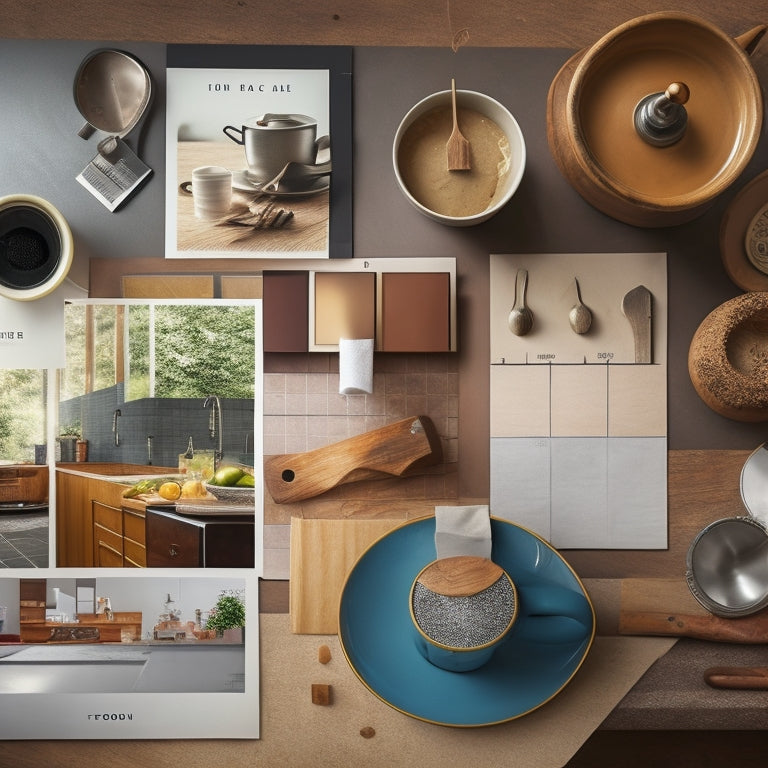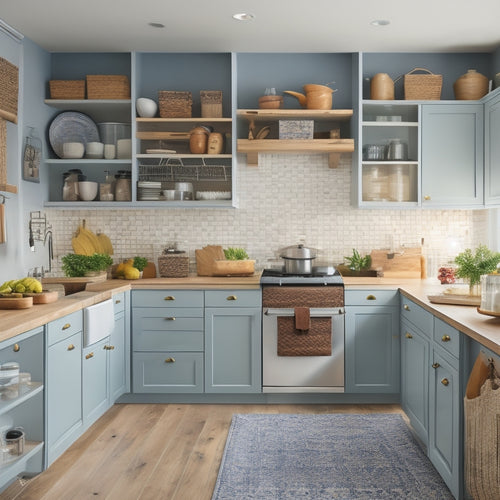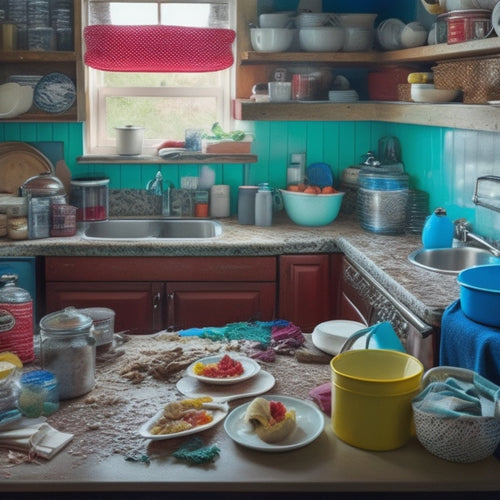
5 Essential Tools for Planning Your Dream Kitchen
Share
You're about to create your dream kitchen, and the right planning tools will guarantee a space that's both aesthetically pleasing and highly functional. Start by designing a well-laid-out space with the Work Triangle concept and Space Hierarchy. Visualize your dream space with mood boards and dreamscaping, selecting a color palette and mixing textures for depth. Measure accurately with calculators and virtual assistants to avoid costly mistakes. Prioritize functionality by focusing on movement and task zones. Finally, bring your vision together by converging layout, lighting, color, texture, and style. Get ready to uncover the secrets to turning your vision into a stunning reality.
Key Takeaways
• Accurate calculators and measurement tools help ensure a seamless fit for your dream kitchen and avoid costly mistakes.
• Virtual assistants and 3D modeling tools enable visualization of your kitchen design and layout.
• Mood boards and dreamscaping tools bring your vision to life and help solidify your design preferences.
• Color palette selection tools aid in choosing a cohesive color scheme that sets the desired mood for your kitchen.
• Layout and design software facilitate the creation of a functional and efficient kitchen space by optimizing the Work Triangle and Task Zones.
Kitchen Layout Design Essentials
As you envision your dream kitchen, the foundation of a functional and aesthetically pleasing space begins with a well-thought-out kitchen layout design that flows seamlessly, combining form and function.
A well-designed layout guarantees a safe and efficient cooking experience, allowing you to move freely and effortlessly throughout the space.
At the heart of a functional kitchen lies the Work Triangle concept, where your sink, stove, and refrigerator form the three points of a triangle. This layout minimizes walking distances, reduces clutter, and creates a sense of harmony.
To further enhance the flow, consider a Space Hierarchy, where zones are designated for specific tasks, such as food preparation, cooking, and cleanup. This hierarchical approach streamlines your workflow, ensuring that each area is optimized for its intended purpose.
Visualizing Your Dream Space
You step into your dream kitchen, and the first thing that catches your eye is the warm, inviting ambiance that radiates from the carefully chosen color palette, textures, and lighting. To bring this vision to life, you'll need to visualize your dream space. This is where mood boards and dreamscaping come in. A mood board is a visual representation of your design style, featuring images, colors, and textures that evoke the desired mood. Dreamscaping takes it a step further, allowing you to imagine yourself in the space, contemplating how you'll move, interact, and feel.
Here's a breakdown of the elements to ponder when visualizing your dream kitchen:
| Element | Description | Tips |
|---|---|---|
| Color Palette | Warm, cool, or neutral tones | Choose 3-5 colors that complement each other |
| Textures | Matte, glossy, rough, or smooth | Mix textures to add depth and visual interest |
| Lighting | Natural, overhead, or task lighting | Contemplate the type of lighting that suits your needs |
Measuring Made Easy Tools
Take precise control of your kitchen design by leveraging measuring made easy tools that help you map out every nook and cranny, guaranteeing a seamless fit for your dream space. With accurate calculators, you can confidently measure your kitchen's dimensions, taking into account any obstacles or irregularities. These calculators allow you to input your measurements and receive precise calculations, eliminating the risk of human error.
Virtual assistants can also be a valuable resource in measuring your kitchen. These digital tools can help you create a 3D model of your space, allowing you to visualize your design and make adjustments in real-time. This ensures that your kitchen design is both functional and aesthetically pleasing.
By using measuring made easy tools, you can avoid costly mistakes and secure a safe and efficient installation process. With precise measurements, you can confidently move forward with your kitchen design, knowing that every element will fit together perfectly.
Designing for Functionality First
When envisioning your dream kitchen, prioritize functionality by imagining yourself moving through the space, effortlessly getting around between cooking, cleaning, and socializing areas. You want to guarantee that every step, every turn, and every reach is safe and efficient.
To achieve this, focus on creating a well-designed Work Triangle, where your sink, stove, and refrigerator form the points of a triangle. This layout allows you to move seamlessly between tasks, reducing walking distances and minimizing hazards.
Divide your kitchen into Task Zones, each dedicated to a specific activity, such as food preparation, cooking, and cleaning. This segregation helps maintain a clutter-free environment, reducing the risk of accidents and making it easier to clean up.
As you design your kitchen, consider the 'zones' you'll need and how they'll interact. For instance, a cooking zone might include a stove, oven, and prep area, while a cleaning zone might feature a sink, dishwasher, and trash disposal.
Bringing Your Vision Together
As you move forward in planning your dream kitchen, it's time to bring your vision together. Six key elements will now converge to bring your dream kitchen to life: layout, lighting, color, texture, pattern, and style. These elements will work together to create a cohesive space that reflects your personal style and meets your needs.
To visualize your kitchen design, create a Mood Board, a visual representation of your ideas and inspiration. Pin up images, fabrics, and materials that evoke the mood and atmosphere you want to achieve. This will help you distill your design preferences and identify common themes.
-
Identify your Color Palette by selecting 3-5 core colors that resonate with your design style.
-
Experiment with different textures and patterns to add depth and visual interest to your kitchen.
-
Consider the style of your kitchen, whether it's modern, traditional, or a fusion of both, to guarantee a cohesive look.
Frequently Asked Questions
Can I DIY My Kitchen Design or Do I Need a Professional?
You can DIY your kitchen design using kitchen software, but if you're unsure or have a complex design budget, consider hiring a pro to guarantee safety and avoid costly mistakes that'll leave you cooking up regrets.
How Do I Choose the Right Materials for My Kitchen Counters?
"As you envision your kitchen's crown jewel, imagine a countertop that's both a stunning canvas and a durable fortress. You'll want materials that marry aesthetics with durability, ensuring your dream space remains safe and beautiful for years to come."
What Is the Ideal Kitchen Lighting Layout for Task Areas?
You're designing your ideal kitchen lighting layout for task areas! Consider layering ambient lighting with focal points, like under-cabinet LEDs, to create a safe and visually appealing space that's perfect for food prep and cooking.
Can I Repurpose or Reuse My Existing Kitchen Appliances?
You're wondering if you can breathe new life into your old appliances! Conduct an appliance assessment to identify what's worth keeping, then get creative with budget-friendly refurbishments or repurposing to give your kitchen a fresh, safe, and functional look.
How Long Does a Typical Kitchen Renovation Project Take to Complete?
"Are you ready to turn your kitchen into a culinary haven? You're probably wondering, how long will this transformation take? A typical kitchen renovation project can take 3-6 months to complete, broken down into distinct renovation phases, ensuring a smooth and safe project timeline."
Related Posts
-

Mastering Kitchen Organization: 7 Expert Tips Inside
You're just a few simple strategies away from transforming your kitchen into a highly functional and efficient space ...
-

What's Holding You Back From a Clutter-Free Kitchen?
You're struggling to achieve a clutter-free kitchen because one or more of eight common obstacles are standing in you...

